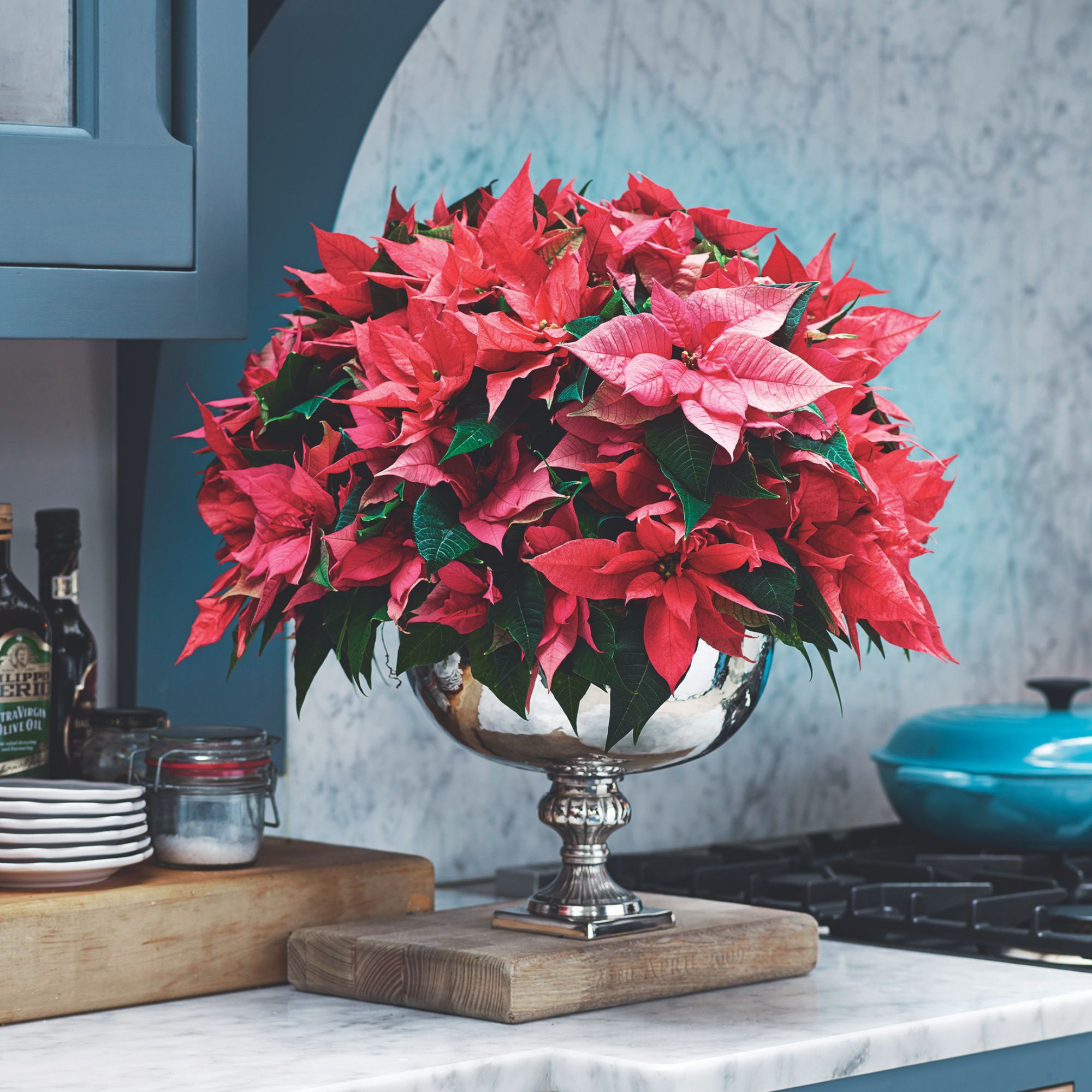8 common Christmas cactus problems – how to spot them and solve them before it's too late
Wondering what's wrong with your Christmas cactus? Take a look at our guide...


Sophie King
Christmas cacti are among the easiest houseplants to care for, but that doesn't mean you won't encounter a few Christmas cactus problems now and then.
It's one of the best Christmas houseplants for a reason – caring for a Christmas cactus is simple, and it's one of the lowest-maintenance houseplants out there. But as with all indoor plants (even the most unkillable houseplants), there's bound to be a couple of hiccups along the way.
We've rounded up the most common Christmas cactus problems with solutions from the experts to help you troubleshoot any issues you face with this festive favourite.
Common Christmas cactus problems
Learning how to spot potential Christmas cactus problems will ensure your plant has the best chance of blooming and flourishing every winter.
'The Christmas cactus is known for its vibrant green foliage and red and pink blooms that typically appear between November and February,' says Andy Little, houseplant buyer at British Garden Centres. 'This makes it a perfect festive plant.'
To keep your plant looking its seasonal best, here are some of the most common Christmas cactus problems to watch out for.
1. The plant isn't flowering

Of all the Christmas cactus problems, no-show flowers are probably the most disappointing.
Get the Ideal Home Newsletter
Sign up to our newsletter for style and decor inspiration, house makeovers, project advice and more.
There are many reasons why your cactus isn't blooming, from over- or underwatering to unfavourable temperatures, but thankfully, most are easy to solve.
First, you'll need to figure out how often to water a Christmas cactus. But one of the best ways to get a Christmas cactus to bloom is to make sure you're giving it enough darkness in the lead-up to its flowering period.
Sounds counter-intuitive, right? Well, those cooler, darker spells are exactly what the plant needs to thrive.
'To encourage blooming, ensure your cactus gets cooler nights and about 12-14 hours of darkness in the lead-up to its flowering period,' advises Jo Lambell, founder of Beards & Daisies.
2. Red or pink leaves

One of the best living room houseplant ideas for Christmas living room decor, Christmas cacti should have rich green leaves.
If you notice the leaves turning red or pink, you've spotted one of the most common Christmas cactus problems. It usually means your plant is receiving too much sun.
'Excessive sunlight may be causing this,' explains Andy from British Garden Centres. 'Relocate the plant to a shadier spot.'
A bright spot, out of direct sunlight, is the perfect location for a Christmas cactus. Once the plant has been moved, its leaves should return to their beautiful green hue within a few weeks.
3. Wilting

There are two reasons for a wilting Christmas cactus: overwatering or underwatering. Luckily, it's easy to determine the culprit.
Pop your finger into the soil. If it feels dry, then you're probably underwatering the plant; if it feels wet (or sodden), then the cause is likely overwatering.
Underwatering has a simple fix. Submerge the pot in water for a few minutes and wait until all the bubbles have stopped. Then, let the plant drink its fill.
After that, take the plant out of the water and let it stand in an empty saucer. Increase the frequency of watering, but make sure you check that the soil is dry before each water to prevent overwatering. If you find that your soil is drying out very quickly (every day or two), then you need to repot it into a larger pot.
Overwatering is more complicated to solve, but knowing how to save an overwatered plant will give you a great starting point.
'Remove the plant from its pot, rinse the roots, trim away any rotten sections, and replant in fresh, well-draining soil,' advises Andy.
4. Mushy leaves and stems

Mushy Christmas cactus leaves and stems are a clear sign of severe overwatering.
To save your plant, start by removing the cactus from its pot and inspecting the damage under the surface. Remove the soil – you can wash it off if needed – and look for signs of root rot. Root rot means the roots will be squishy and are likely to smell bad.
'Once set in, root rot can be nigh on impossible to recover from, so it's best to keep a keen eye out for any signs of overwatering,' says Jo from Beards & Daisies. 'If you’re worried the roots have already begun to rot, then we recommend repotting your plant and snipping off any damaged roots.'
Once you've removed any affected areas, including damaged leaves, repot the plant in dry, well-draining compost (cactus compost like the Miracle-Gro Cactus, Succulent and Bonsai Premium Peat Free Compost from Amazon is a good choice) and a pot with good drainage holes. You should then reduce your watering frequency.
5. Lack of growth

Christmas cacti are fast-growing plants, so a lack of growth is a sure sign of Christmas cactus problems.
Start by learning how to repot your Christmas cactus – it could be that it's in the wrong pot. Opt for a container with good drainage and a snug fit for the plant, as Christmas cacti don't like spacious pots or planters.
The plant might also be lacking the nutrients it needs to thrive.
Evie Brownlee, plant expert at Grow Urban, recommends maintaining the nutrients throughout the year by feeding with cacti and succulent feed. Something like the Westland Cacti & Succulent Plant Feed from Amazon should do the trick.
6. Brown, wrinkled leaves
Brown and wrinkled leaves are another sign of a problem with your watering.
'If your cactus has wilting brown leaves, it has likely been overwatered,' says Julian Palphramand, head of plants at British Garden Centres.
You know the drill – take the plant out of its pot, remove the damaged sections and repot it in fresh soil.
7. Dropping buds

Dropping buds can be frustrating and disappointing, especially when you were expecting beautiful blooms. Sadly, it's another one of the more common Christmas cactus problems.
It's often caused by fluctuations in temperature, so once your cactus starts to bud, try not to move it.
There are also certain spots to avoid when choosing a place for a Christmas cactus. 'Keep your plant away from draughts and radiators,' says Kelly Dyer, indoor house plant expert at Patch Plants. 'Hit it with humidity by misting it daily or keeping it in the kitchen or bathroom.'
8. Grey mould

If you've noticed grey mould on the leaves of your Christmas cactus, it might have fallen victim to botrytis blight.
'Grey mould on the leaves is a sign of this fungal disease, says Andy from British Garden Centres. 'This means the affected plants must be discarded to prevent the spread of the disease.'
Where to buy a Christmas cactus
If you've taken the last resort and thrown your plant away, or you just want to add to your Christmas cactus collection, here's where you can buy another one...
FAQs
What are the signs of overwatering a Christmas cactus?
Overwatering is the cause of a great number of Christmas cactus problems, but luckily, there are some tell-tale signs that you've overdone it.
Soft, mushy leaves which have turned brown or withered are hallmarks of overwatering. If you're wondering why your Christmas cactus is dropping leaves, there's a good chance that overwatering is to blame for that, too.
What does a stressed Christmas cactus look like?
Christmas cacti are very expressive, so it's easy to tell if they're under stress.
An unhealthy Christmas cactus will often have drooping leaves that either feel mushy or very thin. It may also have a mushy base or be floppy, and will generally not look plump and green.
Keep this guide handy the next time you inspect your Christmas cactus.

Holly is one of Ideal Home’s content editors. Starting her career in 2018 as a feature writer and sub-editor for Period Living magazine, she has continued this role also adding regular features for Country Homes & Interiors and the Ideal Home website to her roster. Holly has a passion for traditional and country-inspired interiors – especially kitchen design – and is happiest when exploring the countryside and hills of the Lake District. A keen gardener, she is a strong believer that you can never have too many houseplants.
- Sophie KingGardens Editor
-
 Will a conservatory add value to your home and how can you maximise it?
Will a conservatory add value to your home and how can you maximise it?This is what the pros say
By Amy Reeves
-
 I’ve been looking for a new signature scent for my home and The White Company's new fragrance is the exact summer holiday smell I needed
I’ve been looking for a new signature scent for my home and The White Company's new fragrance is the exact summer holiday smell I neededSantorini smells fresh, summery and sophisticated
By Kezia Reynolds
-
 How to remove algae from garden walls in five steps – and the cleaning product experts rave about for tackling it fast
How to remove algae from garden walls in five steps – and the cleaning product experts rave about for tackling it fastExperts share their top tips for getting garden walls algae-free
By Katie Sims
-
 Gardeners reveal how to recycle your wrapping paper into mulch to regulate soil temperature and prevent weeds
Gardeners reveal how to recycle your wrapping paper into mulch to regulate soil temperature and prevent weedsGive your plants a helping hand with your unwanted wrapping paper
By Kezia Reynolds
-
 Decorating the outside of your house with Christmas lights? These are the 8 things experts want you to know before you start
Decorating the outside of your house with Christmas lights? These are the 8 things experts want you to know before you startGive your home a warm and welcoming feel by illuminating its exterior with twinkling lights, whatever the season
By Holly Reaney
-
 How to repot a Christmas cactus – and the signs your plant needs a larger pot
How to repot a Christmas cactus – and the signs your plant needs a larger potRepot your Christmas cactus in five simple steps
By Sara Hesikova
-
 How to make a poinsettia turn red - the trick is putting it in the dark, but you must get the timing right
How to make a poinsettia turn red - the trick is putting it in the dark, but you must get the timing rightWhen to put a poinsettia in the dark, according to experts
By Lauren Bradbury
-
 Does the Christmas tree boiling water hack work? Why experts are warning real Christmas tree owners to dodge this popular trick
Does the Christmas tree boiling water hack work? Why experts are warning real Christmas tree owners to dodge this popular trickIt works, but it's risky
By Lauren Bradbury
-
 Why is my poinsettia dropping leaves? 5 common causes and how to rescue your plant
Why is my poinsettia dropping leaves? 5 common causes and how to rescue your plantWondering why your poinsettia is shedding its leaves? We asked the experts...
By Lauren Bradbury
-
 How to care for poinsettias – 8 ways to help them thrive, from choosing a healthy plant to the perfect watering schedule
How to care for poinsettias – 8 ways to help them thrive, from choosing a healthy plant to the perfect watering scheduleA complete guide to caring for a healthy poinsettia plant
By Sophie King
-
 20 Outdoor Christmas decor ideas to ensure your home is as festive outside as in
20 Outdoor Christmas decor ideas to ensure your home is as festive outside as inExtend your festive decor beyond your front door and bring a seasonal look to all your outdoor spaces this Christmas
By Holly Walsh


